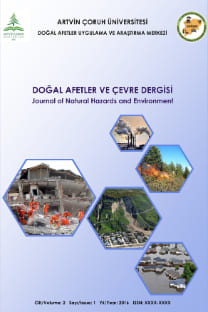Farklı Malzemeler ve Geosentetiklerin Yol Dolgusu Güvenliğine ve Davranışına Etkileri
The Effects of Different Materials and Geosynthetics on Embankment Safety and Behavior
___
- Ahirwara S.K., Mandala J.N., (2017), Finite element analysis of flexible pavement with geogrids, Procedia Engineering, 189, 411- 416.
- Ali M.M.Y., (2012), Geotechnical characteristics of recycled glass in road pavement applications, Doktora Tezi, Swinburne University of Technology, Melbourne, Avustralya.
- Arulrajah A., Piratheepan J., Disfani M.M., Bo M.W., (2013), Geotechnical and geoenvironmental properties of recycled construction and demolition materials in pavement subbase applications, Journal of Materials of Civil Engineering, 28, 1077–88.
- Brinkgreve R.B.J., Broere W., Waterman D., (2018), Plaxis 2D tutorial, Netherlands. https://www.researchgate.net/publication/ 262012153_Plaxis_2D_-_Version_8, [Erişim 15 Haziran 2019].
- Çiçek E., Güler E., Yetimoğlu T., (2015), Sedde şevlerinin geosentetik ile donatılandırılmasının stabiliteye etkileri, EÜFBED - Fen Bilimleri Enstitüsü Dergisi, 8(1), 100-114.
- Djellali A., Houam A., Saghafi B., Hamdane A., Benghazi Z., (2017), Static analysis of flexible pavements over expansive soils, International Journal of Civil Engineering, 15, 391–400.
- Evangelista L., Brito J., (2007), Mechanical behaviour of concrete made with fine recycled concrete aggregates, Cement and Concrete Composites, 29 (5), 397-401.
- Herrador R., Perez P., Garach L., Ordonez J., (2012), Use of recycled construction and demolition waste aggregate for road course surfacing, Journal of Transportation Engineering, 138(2), 182-190.
- Jamsawang P., Yoobanpot N., Thanasisathit N., Voottipruex P., Jongpradist P., (2016), Three-dimensional numerical analysis of a DCM column-supported highway embankment, Computers and Geotechnics, 72, 42–56.
- Liu H., Won M.S., (2009)., Long-Term Reinforcement Load of Geosynthetic-Reinforced Soil Retaining Walls, Journal of Geotechnical and Geoenvironmental Engineering, 135(7), 875-889.
- Molenaar A.A.A., van Niekerk A.A., (2002), Effects of gradation, composition, and degree of compaction on the mechanical characteristics of recycled unbound materials, Journal of the Transportation Research Board, 1787(1), 73–82.
- Oikonomou N.D., (2005), Recycled concrete aggregates, Cement and Concrete Composites, 27(2), 315-318.
- Park T., Tan S.A., (2005), Enhanced performance of reinforced soil walls by the inclusion of short fiber, Geotextiles and Geomembranes, 23, 348–361.
- Poon C.S., Chan D., (2006), Feasible use of recycled concrete aggregates and crushed clay brick as unbound road sub-base, Construction and Building Materials, 20(8), 578-585.
- Rahman M.A., Arulrajah A., Piratheepan J., Bo M.W., Imteaz M.A., (2013), Resilient modulus and permanent deformation responses of geogrid-reinforced construction and demolition materials, Journal of Materials of Civil Engineering, doi: 10.1061/(ASCE)MT.1943-5533.0000824.
- Ramos-García J.A., Castro M., (2017), Linear visco-elastic behavior of asphalt pavements: 3D-FE response models, Construction and Building Materials, 136, 414–425.
- Saevarsdottir T., Erlingsson S., (2015), Modelling of responses and rutting profile of a flexible pavement structure in a heavy vehicle simulator test, Road Materials and Pavement Design, 16(1), 1–18.
- Yu Y., Jianhui Z., Xu Z., Xiaodong P., Hongwei L., Hao C., (2017), Finite element analysis of embankment with soft foundation reinforced by geogrids, Modern Civil and Structural Engineering, 1(1), 78-83.
- Zhang J., Zhu C., Li X., Pei J., Chen J., (2017), Characterizing the three-stage rutting behavior of asphalt pavement with semi-rigid base by using UMAT in ABAQUS, Construction and Building Materials, 140, 496–507.
- ISSN: 2528-9640
- Yayın Aralığı: 2
- Başlangıç: 2015
- Yayıncı: Artvin Çoruh Üniversitesi Doğal Afetler Uygulama ve Araştırma Merkezi
Mamadou TRAORE, Senem TEKİN, Tolga ÇAN
Termal Uzaktan Algılama Görüntüleri İle Yüzey Sıcaklıklarının Belirlenmesi: Kocaeli Örneği
Orman Yangın Yönetiminde Etkili Bir Karar Destek Sisteminin Kavramsal Çerçevesi
KADİR ALPEREN COŞKUNER, Ertuğrul BİLGİLİ
Bingöl İl Merkezinde Taşkın Yayılım Alanlarının Coğrafi Bilgi Sistemleri ve HEC-RAS ile Belirlenmesi
Murat ÇELİKLER, Nilüfer NACAR KOÇER, Osman YILDIZ
Batı Karadeniz Bölgesinde Kuraklık İndisleri Üzerine Trend Analizi Uygulanması
Perde-Çerçeve Sistemlerde Rijitlik ve Kayma Merkezi
Kanat Burak BOZDOĞAN, Süleyman AYDIN
Taşkın Frekans Analizinde Eşik Üstü Pikler Yönteminin Seyhan Havzası’nda Uygulanması
Yusufeli Barajı Antropojenik Etkilerinin Peyzaj Planlama Açısından Değerlendirilmesi
Uluabat Gölü Noktasal Kirletici Kaynaklar ve Kirlilik Yükleri
